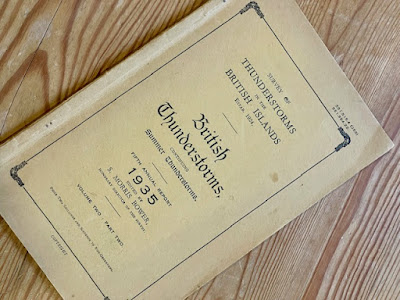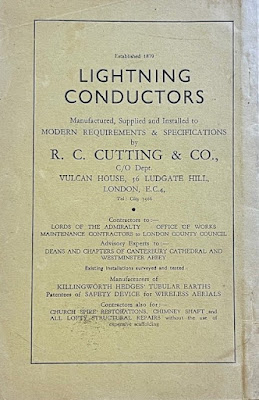It was hardly to be expected that I would resist a booklet in pale orange wrappers entitled British Thunderstorms, with the subtitle ‘Continuing Summer Thunderstorms’ (1935), edited by S. Morris Bower, as part of the Survey of Thunderstorms in the British Islands, Estab. 1924. The publisher of this went under various names, latterly as The Thunderstorm Census Organisation.
The archipelago of Britain and Ireland often has changeable weather conditions, of abiding interest to its inhabitants, and from Edwardian times at least there was a great deal of amateur enthusiasm in observing and recording these. I first encountered this in a splendid book, British Rainfall 1910, which I found at the Ilkley Book Fair in the Winter Gardens of the little spa town. The narrative reports in this struck me as so characterful, with a mood of melancholy about them, that I selected and arranged some for my found poem ‘Rain Instruments’.
I later chanced upon a copy of Symons’s Meteorological Magazine for 1909, which listed articles on a white rainbow, black rain, and an Easter snowstorm, and had headings which sounded like the titles of short stories: ‘Hot Wind at Lynmouth’, ‘Summer Frosts’, ‘Weather Reports of a Peach Tree’. I depicted just such a weather periodical, The Barograph, in my story ‘Armed for the Day of Glory’ (in This World and That Other, a shared book with John Howard, Sarob, 2022).
In his Foreword to this issue of British Thunderstorms, written from Langley Terrace, Oakes, Huddersfield, on October 8th, 1938, S. Morris Bower thanks the 1,217 voluntary recorders who have contributed to the survey. He also reveals that there was a sister publication to Summer Thunderstorms, entitled Winter Thunderstorms (which sounds even better), but the two are now amalgamated in this new form. He acknowledges the help not only of the Met Office, but of the Elder Brethren of Trinity House, the Commissioners of Northern Lights, and the Commissioners of Irish Lights. All three of these sound like the leaders of revivalist sects, but are in fact lighthouse services.
The journal, as might be expected, has a lot of tables, charts and maps. But there are also narrative reports, starting with the Fifth Annual Report for 1935, a synopsis of storms throughout the year: ‘The Summer of 1935 was noteworthy for its thunderstorms. The total number of days with thunder or lightning in the British Isles reached 122 . . . it is interesting to observe . . . an unusually large amount of thunder in June 1935’.
More detailed notes on the months follow, with local information. Here there was an exciting allusion to my own county of origin: ‘The series of thunderstorms which culminated in the Great Northamptonshire Hailstorm of September 22nd, 1935 are of special interest because they indicate that four squall lines passed over Southern Britain during the preceding hours’ (italics in original). Four squall lines eh? Sadly, we do not hear more of the Great Hailstorm.
Next follow the special interest reports, starting with a regular ‘Report on Trees Struck by Lightning’: there were 59 reports for 1935. This naturally put me in mind of the song ‘The Lightning Tree’, as performed by The Settlers, with its very catchy chorus (‘Grow, Grow, The Lightning Tree, it’s never too late for you and me’). The most frequently struck (because, I suspect, tallest and commonest) were Ash, Oak, Elm, and Poplar, but there were also two each of Cedar, Sweet Chestnut, Sycamore and Wellingtonia. However, there are more thrills to come in the section on ‘Strokes of special interest, 1935’, as witness this report:
‘Lightning struck in the middle of a field of Brussels sprouts in Leicestershire (16th June, 1935). The young plants over an area of about ten square yards were killed and there was a small hole in the centre about “ten inches round and about ten inches deep”. A boy dug into the hole to try to find a “thunderbolt”, and reported discovering some blackened stones: but the farmer himself did not see them and was distinctly sceptical — “You know what boys are!” he said.’
It sounds like a Young Adult Fantasy: The Boy Who Dug for Thunderbolts. And I suspect that boy would go far. No doubt he sold or swapped some of his scorched stones, claimed to be thunderbolts, to his friends, in return for cigarette cards, stamps or marbles.
A new specialist section is a ‘Report on Damage to Land Transport’, which discusses lightning strikes on bicycles, trams, cars and carts. There had been 19 reports, supporting the idea that ‘such damage is comparatively rare’, although two motorists and one cyclist had been left in a shocked or dazed condition, as one might well imagine. In another case ‘the roof of a saloon car was marked with a tree-like pattern after the flash’, but the occupants were uninjured. Nevertheless, despite the rarity, the report offers advice to drivers, compiled by Mr S T E Dark:
‘Try to race the storm, where speed permits, but failing this make for a well-wooded region, and drive the car in under a beech tree for preference or, failing a beech, under some other smooth-barked tree such as a sycamore or horse-chestnut’.
I am sure I have read some Thirties thrillers where our clean-cut hero and his flapper girlfriend ‘try to race the storm’ through the narrow English lanes at night. Perhaps they had read Mr Dark’s advice. He is listed in the journal as Sidney T.E. Dark, M.Sc., M.R.S.T., of 21 Fernwood Avenue, Streatham, London SW16, and I think this must be author and journalist of the same name, who was for a while the editor of John O’London’s Weekly, the book magazine, and the Church Times. ‘Try to race the storm’ has rather the flavour of a maxim for life generally.
After all these salutary examples there is, shrewdly enough, a back cover advertisement for lightning conductors from R C Cutting & Co, of Vulcan House, 56 Ludgate Hill, EC4, contractors and advisers not only to The Lords of the Admiralty and the Office of Works, but also the Deans and Chapters of Canterbury Cathedral and Westminster Abbey, for lightning may strike the high and the low, the sacred and the profane. And just in case, they also contract for ‘All Lofty Structural Repairs’.
(Mark Valentine)


I always enjoy these essays of yours in which weather reports are spun into Poetry. There is a certain sad fragility to the image of serious Brits recording weather minutiae and collecting meteorological data into neat charts. And, on occasion, an ominous Fortean quality hangs over the details that are recounted of singular storms- as if these events were portents of an even greater metaphysical doom. I loved your speculative book titles and maxims as well.
ReplyDeleteMy girlfriend pays for some fancy online weather reports, and the last time she drove from Chicago to my home in Missouri, she stayed "five or six minutes" ahead of a huge thunderstorm, just by checking her phone and increasing her speed when necessary.
ReplyDelete